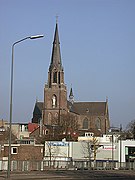|
Helmond
Helmond (Dutch pronunciation: [ˈɦɛlmɔnt] ; called Héllemond in the local dialect) is a city and municipality in the Metropoolregio Eindhoven of the province of North Brabant in the Southern Netherlands. Helmond is home to several textile and metal companies. The Vlisco factory is located next to the Zuid-Willemsvaart canal, which runs through the city.[5] The spoken language is Helmonds (an East Brabantian dialect).[6] HistoryEtymology and coat of armsHelmond's coat of arms, first appearing in 1241, displays a helmet, and is a canting arms for the city's name, as helm means helmet in Dutch. However, the actual etymology of Helmond's name is probably derived from the combination of Hel, which means "low-lying" (from Proto-Germanic *haljæ / Hel), and Mond, which referred to higher ground or a secure place.[7] The helmet on the coat of arms originally was depicted as a medieval great helm, however, the design eventually came to depict a jousting helmet. The oak sprigs symbolize freedom, while the bird perched on them is thought to be purely decorative.    Medieval and early modern periodsDuring the Merovingian period, the site of what is now Helmond was an only partially habitable convergence of streams. As the streams began to silt over, settlement was made possible, and by the year 1000, a settlement arose west of what is the current city center. Additionally, a precursor to the current Helmond Castle, named 't Oude Huys ("the old house"), was built around this time. Documents from 1108 mention Lord Hazelo von Helmond, the first feudal lord of the allodium of Helmond. In 1179, a bull of Pope Alexander III mentions Helmond being donated to the Abbey of Floreffe. At this point, the local feudal administration was probably moved to t' Oude Huys. In 1220, Helmond came under the control of Henry I of Brabant. In 1225, the town was founded by Henry, it received its Town Privileges in 1232. Following his death in 1235, it was passed down to his daughter, Maria of Brabant, Holy Roman Empress, who spent much time at t' Oude Huys and whose founding of Binderen Abbey benefited the growth of the city. Upon her death in 1260, the town passed back to the Dukes of Brabant, who, in 1315, leased it to the van Berlaer family. In 1325, Jan II Berthout van Berlaer started the construction of a stone keep on the site of the current Helmond Castle, supplanting t' Oude Huys. By 1400, the city ramparts were built. Having gained market rights in 1376, Helmond's textile industry began to develop, and in 1389, seven guilds were authorized to operate in the town. Merchants from Helmond sold wool and textiles throughout Brabant. Despite the commercial growth, the town's population remained small. Helmond's prosperity soon ended due to war and instability in the Duchy of Guelders, and following Charles V's ascension to the Duchy of Brabant, Helmond was put under siege and sacked by the army of Maarten van Rossum in 1543.[8] Under the Dutch Republic and the Revolutionary eraHelmond was also embroiled in the Eighty Years War. Since it remained loyal to Philip II of Spain, the army of the Dutch Republic twice captured and lost the city, with only the castle remaining uncaptured. The effects of the war and a plague outbreak in 1636 decimated the textile industry in Helmond, and many weavers fled to Haarlem. Only with the peace of 1648 could the city start to recover.[9] The weavers of Helmond gained a fruitful partnership with merchants in Haarlem, and the city could rebuild from the war. Catholics were pushed underground. Although the city recovered its prosperity, it was once again plunged into instability during the Patriottentijd of the late 18th century. Following several skirmishes and political maneuvers in the city, the Patriots were crushed through the intervention of Prussia in 1787, but only five years later in 1793, the French Republic invaded. The liberal French administration allowed the Patriots to re-assert themselves in the city, and in 1795, universal male suffrage came to Helmond. By 1798, the vestiges of the Dutch Republic were abolished, and Catholics were once again allowed to take part in city governance. 19th and 20th centuriesBy the late 18th and early 19th century, local entrepreneurs also started to grow the textile business unassisted by the Haarlem merchants, facilitating industrial production. It became a city with a seat in the Estates of Brabant in 1814.[10] The 1826 opening of the Zuid-Willemsvaart canal, which runs through the city, brought more prosperity to the city. In addition to the weaving mills and the associated yarn dyeing and bleaching plants, other branches of the textile industry also developed, such as cotton printing. The introduction of steam power and construction of a railway station in 1866 greatly accelerated the development of Helmond, and its population greatly increased. By the early 20th century, industry in Helmond started to branch out from textiles: metal products, such as machines and wires, were produced in the city, along with a cocoa factory, a margarine factory, and the grocery chain EDAH. In 1940, Helmond was captured by the Wehrmacht, and its city administration was taken over by NSB collaborators. The city was liberated by the British Army on 24 and 25 September 1944. After the war, industry once again flourished, with new companies establishing themselves in the city while old industries continued. Pursuing a modern image, prominent projects such as the Cube Houses were built. Helmond gained its 80,000th resident in 1999, and continues to grow.[11][12] GeographyHelmond is subdivided into quarters and neighbourhoods:[13]
TransportRailway stations: Helmond, Helmond Brouwhuis, Helmond Brandevoort, Helmond 't Hout Local mediaNewspapers:
Radio:
Television:
News on the internet:
PoliticsMunicipal councilThe municipal council consists of 37 seats. Below the council since 1998:
Notable residents  
Sport
Twin towns — sister citiesHelmond is twinned with:
Gallery
References
External links
|
||||||||||||||||||||||||||||||||||||||||||||||||||||||||||||||||||||||||||||||||||||||||||||||||||||||||||||||||||||||||||||||||||||||||||||||||||||||||||||||||||||||||||||||||||||||||||||||||||||||||||||||||||||||||||||||||||||









